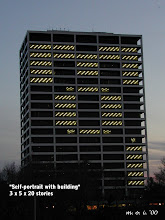Laura DeAngelis’ Celestial Flyways, an interactive sculpture produced as part of Kansas City's Art in the Loop project, was unveiled recently in downtown Kansas City. DeAngelis' work joins a growing list of art projects that have transformed downtown in ways that are arguably more far-reaching that the Power and Light District ever will be. One is about a vision of commerce - what drives it, underlies it, and makes it vital; while the other is simply commerce - the buying and selling of goods and services.
Artists were inhabiting, and in many cases, rehabilitating spaces to live in, to create studios in, places to show their work when city planners were giving your tax dollars to wealthy corporations and providing 25-years of property tax abatement so suburban folks who'd fled the city might consider moving downtown again. The practice of an urban revitalization driven by the arts eventually became institutionalized under the auspices of groups like the Urban Culture Project, and what followed was a revolution for Kansas City.
Today, art is frequently what is used to "sell" downtown as the place to be. Work, live, shop here. It's hip. Look! Art. How cool is that? Indeed. Suburbanites continue to flock into the new urban landscape, this canvas of people and energy that does not exist in cul-de-sacs; they come because art fills a void in their lives.
But artists do not make art for suburban visitors who find security in Ted's Montana Grill. They make it for themselves. Sometimes people see it. Sometimes they do not. To see it, one must take the time to engage oneself in another way of looking. Another way of longing. What is it that I seek? What is it that makes me alive and well in this world? Slow down. Take a moment. Here is a park. Let's sit for a minute.
“Celestial Flyways” can be seen at Oppenstein Brothers Memorial Park, 12th and Walnut streets and like many other large-scale public art projects currently in vogue, it hinges on a collaborative process, this one involving DeAngelis and Davison Architecture + Urban Design LLC. Collaboration can strengthen a work and add dimensions to it that otherwise wouldn't be possible, but sometimes it seems to lend itself to over thinking and a loss of spontaneity.
Given the arduous process to fund, site, and complete any major public works project, lest of all one involving art, that should come as no surprise. Like the vetting of politicians during the campaign season, this lengthy process makes producing any work of public art that throws lightening bolts at conventional wisdom a rarity - unless you happen to believe that art of any kind, is in itself, a practice that shocks the system. There's is some truth to that, but the vetting process typically leaves us with works that reference the controversial in very oblique ways, but frequently without a deep and jarring challenge to our psyche. The challenge for the artist then, in some ways, is how to circumvent the process that will meet the needs of the individual artist, how to find avenues to fund such large projects, and how to make engaging work that doesn't offend the patron. Or at least offend the patron and the public to the point where they stop giving.

In many ways, Celestial Flyways underscores larger problems in our society. As much as art can connect us, it can also remind us of what we've lost. Light pollution in the city obscures the sky to the point that sometimes even seeing the big dipper is a challenge. The city had a chance to install dark-sky approved lighting a few years back and refused to listen to concerned citizens. Naturalists were pitted against THE SOCIETY FOR ILLUMINATING ENGINEERS; the end game was less illustrious than your imagination, which the SOCIETY -for all the light - lacked in abundance. This left the city with an antiquated street light system that spews light in all direction, pollutes the sky, and is terribly inefficient. And one of the biggest proponents of this system was Mark Funkhouser, who then served as city auditor. Funkhouser's argument was that this was the only system that Kansas City could afford. That's clearly the auditor speaking but save a buck, lose the sky. How is that being smart with the money?
Spend some time in this park, down on your hands and knees if must, and examine the tile work. This level of detail, patience, and execution is rare in any work, even more so in a large public art installation. Where else can you find paddlefish cavorting between concrete steps and ladders to clouds? And if I can't see the river or the stars then give me a step ladder to the constellations so I can search my soul for a spoonbill of inspiration.
----------------------------------------------------------------------
The Art in the Loop Foundation is a partnership of the Kansas City Art Institute, the Greater Kansas City Community Foundation, the Municipal Art Commission and the Downtown Council of Kansas City. A 501c3 nonprofit organization, public art projects produced by the program have been supported by a five-year grant from the Greater Kansas City Community Foundation, with matching funds from the City of Kansas City, Mo. for the past three years.
more at:
m.o.i.: art knocked for a loop
Elsewhere:
art in the loop
urban culture project
Thursday, May 8, 2008
art in the loop: laura deangelis' celestial flyways
Posted by
Warrior Ant Press Worldwide Anthill Headquarters in Kansas City, Missouri, USA.
at
6:33 AM

Subscribe to:
Post Comments (Atom)







No comments:
Post a Comment